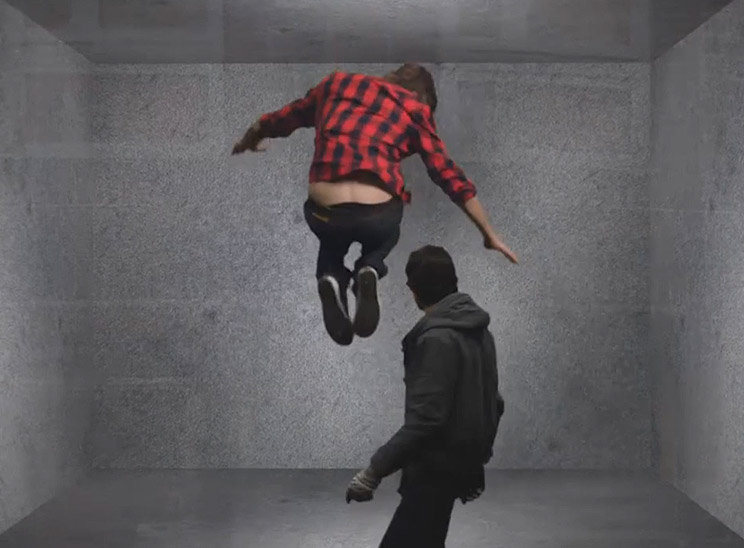


BREAKFAST
Interwoven Existence
The artwork draws inspiration from the concept that individual human beings are interconnected rather than isolated. It is a visual representation of collective strength and diversity. The artwork is divided into sections of various sizes and colors, each symbolizing the diverse origins of people around the world.
As viewers approach the artwork, it becomes interactive, reflecting their image across the piece. Upon stepping away, a recording of their interaction is placed into one of the sections, symbolizing the randomness of a given person’s birthplace and socioeconomic position. Subsequently, recorded video clips of previous viewers are displayed in adjacent sections, integrating new viewers into the existing community of participants.

ERIC SIU
萧子文
エリック·シウ
Touchy
file festival
Touchy is a human camera – a wearable device that literally transforms a human being into a functioning camera. The individual who is wearing the device is constantly “blinded” unless someone touches his/her skin. The touch causes the shutters in front of the eyepieces to open and restores the wearer’s vision. When physical contact is maintained for 10 seconds, the camera takes a “Touch-Snap” (i.e., a photo that is taken by Touchy), which is displayed on the device’s LCD.
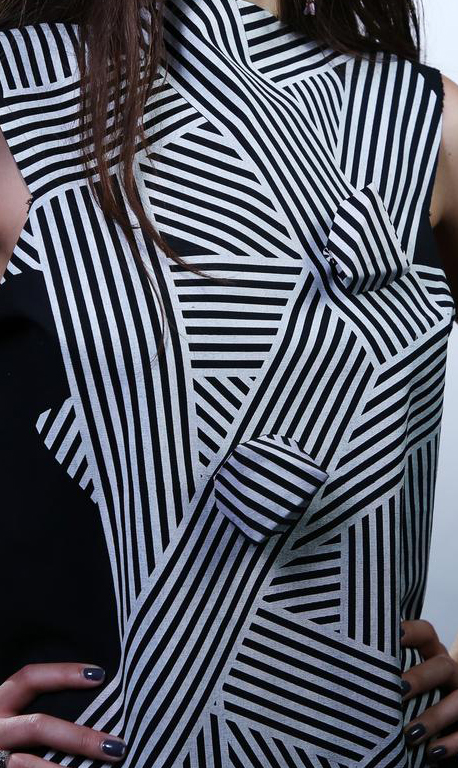
Kino
MIT Media Lab, Stanford University
This work explores a dynamic future where the accessories we wear are no longer static, but are instead mobile, living objects on the body. Engineered with the functionality of 18 robotics, this “living” jewelry roams on unmodified clothing, changing location and reconfiguring appearance according to social context and enabling multitude presentations of self. With the addition of sensor devices, they transition into active devices which can react to environmental conditions. They can also be paired with existing mobile devices to become personalized on-body assistants to help complete tasks. Attached to garments, they generate shape-changing clothing and kinetic pattern designs–creating a new, dynamic fashion.
It is our vision that in the future, these robots will be miniaturized to the extent that they can be seamlessly integrated into existing practices of body ornamentation. With the addition of kinetic capabilities, traditionally static jewelry and accessories will start displaying life-like qualities, learning, shifting, and reconfiguring to the needs and preferences of the wearer, also assisting in fluid presentation of self. We envision a new class of future wearables that possess hybrid qualities of the living and the crafted, creating a new on-body ecology for human-wearable symbiosis.
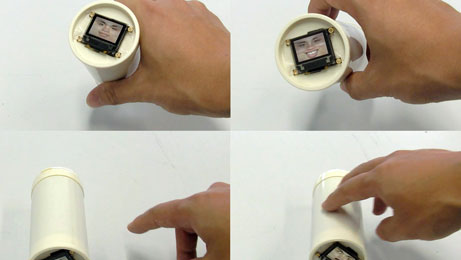
KAZUSHI MUKAIYAMA
IJIROS
file festival
Ijiro is a robot which expresses emotions reacting to a user’s actions. Boldly, it consists of an OLED display, a speaker and an accelerometer in a cylinder shell. Ijiro isn’t able to move itself because it doesn’t have any actuators. However, it expresses emotions with faces in the display and voice from the speaker when a user touches it, lying, standing, swinging, hanging and so on. For example, if a user swings it softly, it reacts smiling. But if a user swings it roughly, it reacts angrily. So those reactions let users feel it like a baby. It is actually baby’s emotions characterized by cognitive science. Also, Ijiro’s shape is designed as a cylinder. It is considered to get various user’s actions because only a cylinder can be stood, lied down, rolled and so on in primitive shapes. Recently it has been easier to use electronic parts for arts. One advantage of making art pieces with compact electronics like a cell phone. So the art style is able to change from being viewed in a large room to being anywhere. Ijiro was developed to entertain people to keep it like a physical pet. We hope you all enjoy touching it.

Mitsuo Katsui
勝井三雄展 兆しのデザイン
Mitsuo is credited with pioneering new forms of visual expression enabled by new technologies. He is a Professor Emeritus at Musashino Art University and Director of Chameleon Project, a member of the Board of Directors of JAGDA and of Japan Display Association. He is also a member of Tokyo ADC and AGI.

UVA
Principles of Motion
For Principles of Motion, UVA uses a rotating LED disc to create an abstract rotating and shifting kinematic landscape that plays with the viewer’s perception of movement and reflects the phenomenon of persistence of vision (sparkler’s trail effect / pov display). By varying the luminosity of the LED, the kinetic landscape moves and gives the viewer a sense of space and time. While observing the abstract rotating patterns and rhythms, the optic nerve of the recipient replicates the effect of an afterimage on the eye.
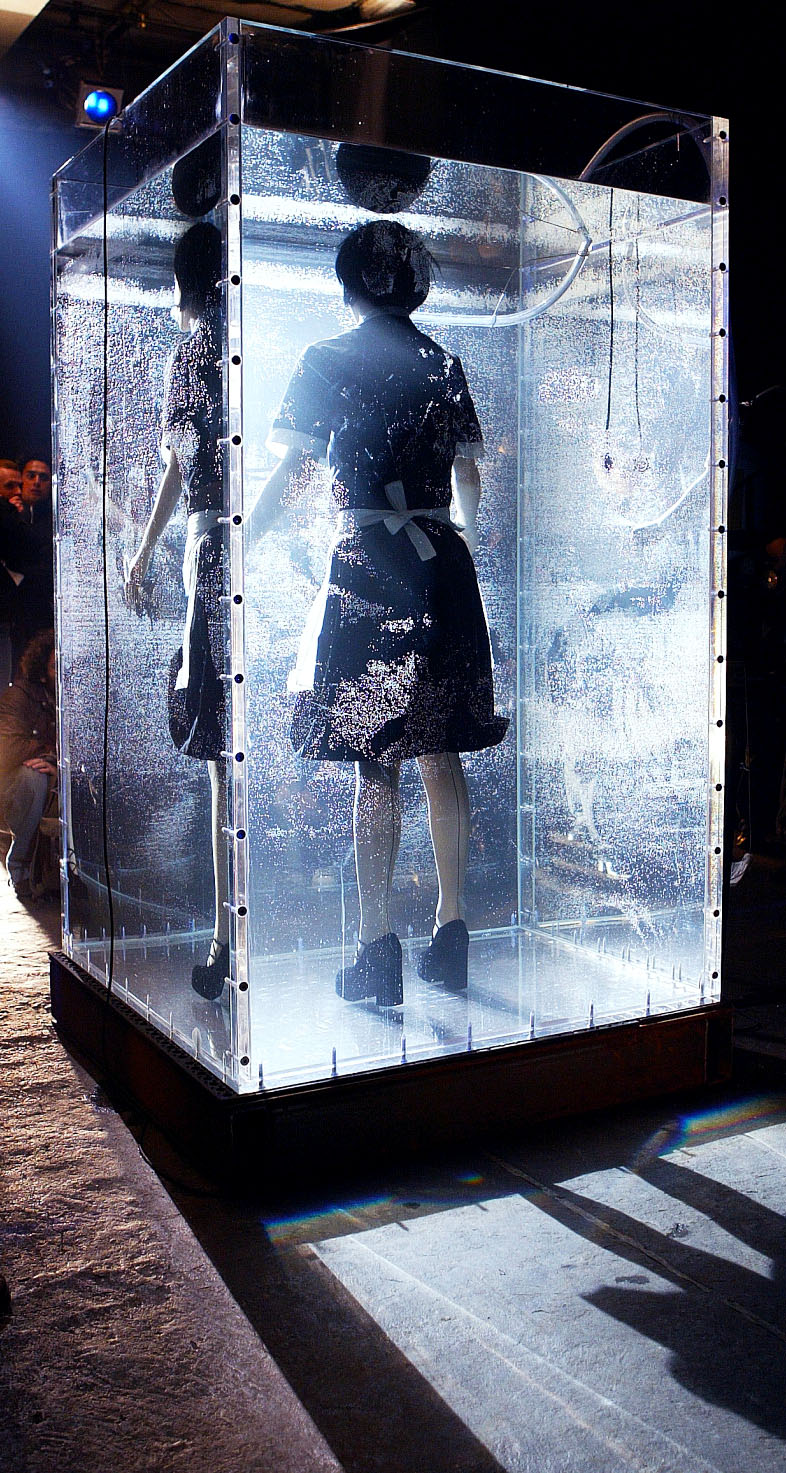
Kris Verdonck
IN
In IN (2003) an actress remains motionless for an hour in a display window filled with water. The distortion to her senses caused by the environment she is in makes her go into a trance. The sounds of her breathing and movement are amplified by microphones.
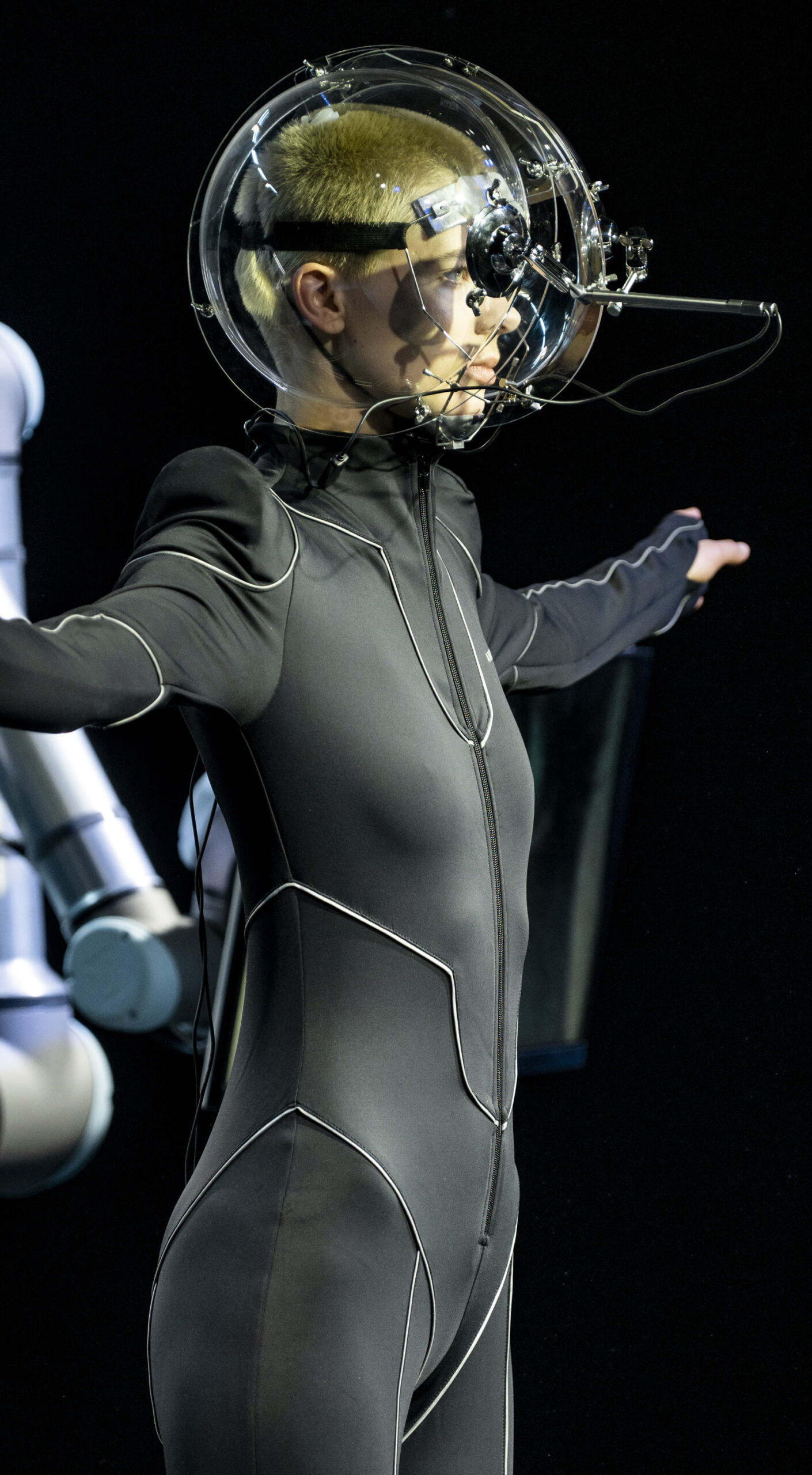
Behnaz Farahi
19Returning the Gaze
‘Returning the Gaze’ is an cyber-physical robotic installation by Behnaz Farahi supported by Universal Robots for ANNAKIKI’s Milan Fashion Week. ‘Returning the Gaze’ is an exploration of this scenario. In the center, a female model wears a spacesuit-like outfit and a headpiece fitted with two tiny cameras. The cameras track and capture the movements of the model’s eyes, and enlarging and displaying them on four monitors mounted moving around on robotic arms glaring back at the observers. The gaze of the model is thereby directed back at the viewer, extended and enhanced through cyborgian technologies.

Bernd Lintermann and Peter Weibel
YOUR:R:CODE
Il titolo può essere letto in due modi diversi: l’interpretazione »your code« indica che nell’installazione i visitatori sperimentano diversi tipi di trasformazioni digitali di se stessi. Mentre entrando, un visitatore vede ancora il suo riflesso familiare in uno specchio – la rappresentazione virtuale più reale che possiamo immaginare – l’immagine speculare si trasforma gradualmente in un corpo di dati digitale finché, infine, il visitatore è ridotto a un codice leggibile industrialmente. Alla fine si libera dalla rappresentazione virtuale e si materializza in un display flip-dot. Il secondo modo di leggere il titolo del pezzo, »tu sei codice«, sottolinea che noi stessi siamo costituiti da codice, che tra l’altro si manifesta nel codice genetico.

Urs Fischer
CHAOS #501
Introducing CHAOS, 501 original works in the form of unique digital sculptures. Each NFT in CHAOS consists of two unique objects (an array of familiar objects to people today) that have been 3D scanned. They are set on a colliding course in motion and orbit. The sculptures, operating as an archeology of the present, are intended to manifest in any format that is capable of displaying, playing or showing a 3D sculpture in motion. The culmination of the project is CHAOS #501, a single entity NFT uniting all one-thousand objects represented in #1-#500.
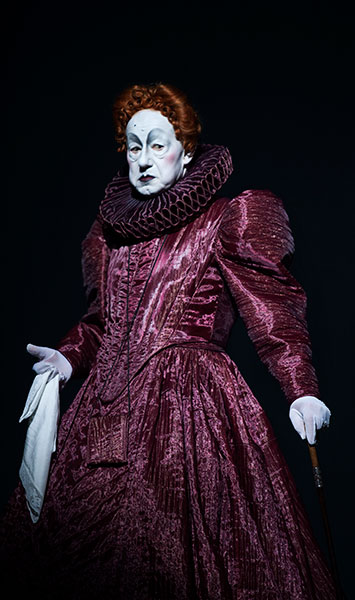
ROBERT WILSON
بوب ويلسون
鲍伯·威尔逊
בוב וילסון
ロバート·ウィルソン
밥 윌슨
Боб Уилсон
SHAKESPEAR`S SONETTES
Staging Shakespeare, not dramatic but lyrical: that was the intention of the American director Bob Wilson in Sonnets de Shakespeares (Sonnets de Shakespeare), a show on display at the Berliner Ensemble. To that end, Wilson is associated with American-Canadian composer and musician Rufus Wainwright. The result is a variety night, with reference to all genres of entertainment, from the commedia dell’arte to television sketches, passing through the cabaret. If in the Elizabethan era female roles were played by men, Bob Wilson did the same, creating this reverse practice: actresses play male roles. This inversion – Queen Elizabeth 1st, on her throne, declaiming a sonnet with a deep voice and Shakespeare himself, as a young man and an elder, in female voices – further intensifies the farcical tone of the show. So much so that even the sporadic number of transvestite actor Georgette Dee, microphone in hand, does not disagree much of the Shakespearean surroundings.
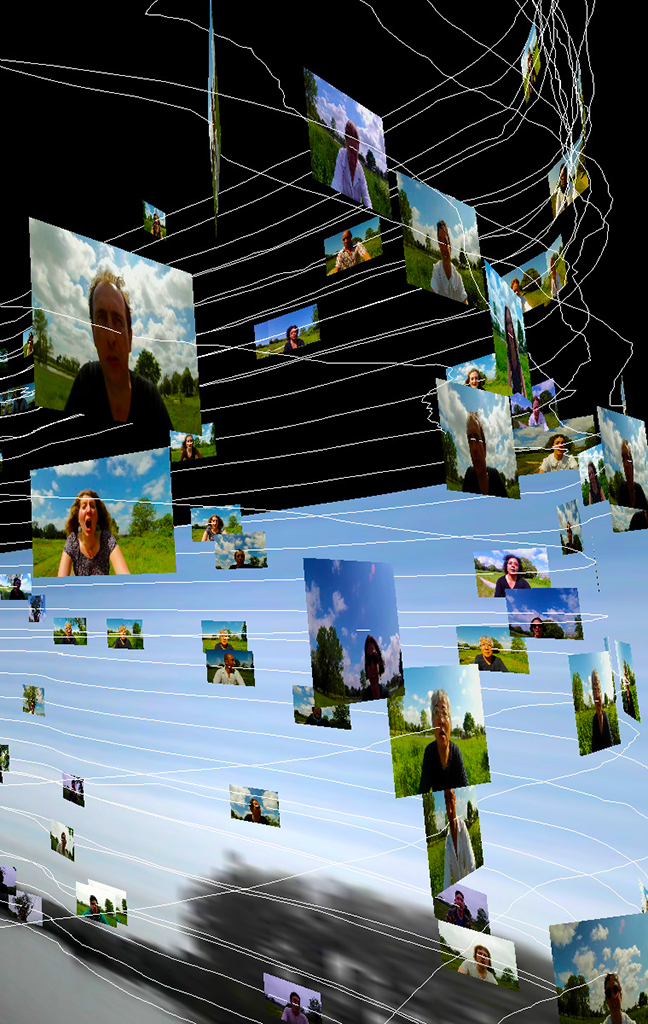
Masaki Fujihata
Voices of Aliveness
This project, upon the initiative of l’Ecole des Beaux-Arts de Nantes, has been conceived as a meta-monument where are gathered video sequences recorded by a camera with GPS. People are screaming while biking in a 500 m circle in the countryside. The traces of this route can be visualized thanks to lines that form a sort of tower in the virtual space, where it can go on indefinitely. On these lines, in an order that looks more like a music score than a succession of shootings, mobile video screens simultaneously display the image of the performances.
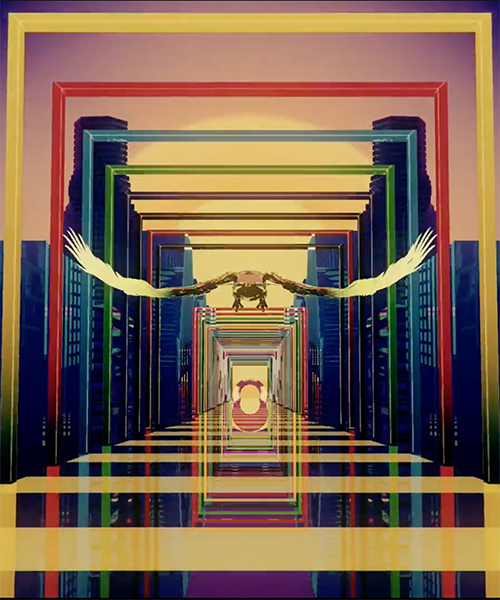
liu chang and miao jing
Hills beyond a river
Music: “CHINA-瓷” by Mickey Zhang
file festival
“Hibanana Studio is a creative art&tech studio, swinging at the intersection of audio-visual performance & installation, moving images and interactive installations. We are inventing new forms of the moving image for display surfaces of the future. A series of interdisciplinary research and practices range from video, sound, light, interaction and spatial experience leads us to artworks, commissions, and exhibition.”

Jon & Vangelis
VANGELIS
R.I.P
Horizon
In amongst the rings of confusion
Silencing the thought powers one by one
It seems all so incredible
Our own ability to confuse – to sacrifice
To enlighten like a shakespearian play
We foolish and happily hold on to sanity
While all around the pushing feelings
The twisting and turning of our hearts
Displaying an almost indefinable strength
Of purpose – a reason a reason a reason
Where no reasons seems to exist
Yet, as in a vision, a voice transcending
All our imagination, jewel of life
Guiding light heralding a joyous new dawn
Clear and gifted time
Divine nature – super nature
The supreme gift of knowledge and space
In this cacophony of life
Peace will come

NORIYUKI SUZUKI
*(Sternchen)
„*(Sternchen) ist eine Installation, die aus einem Armillarsphärenapparat besteht, der einen Apfel um 360 Grad dreht, und vier Kameras, die die Oberfläche des Apfels in Echtzeit omnidirektional scannen. Computer berechnen die Ähnlichkeit zwischen fragmentarischen Bildern des gegenwärtigen Apfels und Äpfeln, die ich zuvor gegessen habe, als wären sie meine Erinnerung an Äpfel. Die Berechnungen und verglichenen Bilder von Apfelfragmenten werden jeweils auf vier Displays angezeigt.“ Noriyuki Suzuki

Laura Splan
Disrupted Domains
Disrupted Domains features new animations created with molecular visualization software and SARS-CoV-2 structures displayed in Quorum at the Science Center. The animations were developed in remote collaboration with uCity Square biotech company Integral Molecular for Splan’s Science Center Bioart Residency while “sheltering in place” for COVID-19. The work in the exhibition is part of Precarious Structures, Splan’s project that explores the interconnectedness of cultural and biological systems during the coronavirus pandemic. Accompanying soundscape by Frank Masciocchi recorded in collaboration with Splan over Zoom.
VIDEO

Rafael Lozano-Hemmer
Saturation Sampler
Rafael Lozano-Hemmer’s work Saturation Sampler, uses AI computer vision to track onlookers and extract the most saturated color palettes from their bodies and clothes, creating a gridded composition from the footage where viewers catch glimpses of their reflections in the pixelated field. With the widest color gamut available and an unparalleled 160-degree viewing angle, Luma Canvas delivers a unique viewing experience unlike any other. The direct emissive nature of the display’s LEDs creates a visceral and material encounter with Lozano-Hemmer’s interactive work, meaningfully situating his digital work within the physical realm.
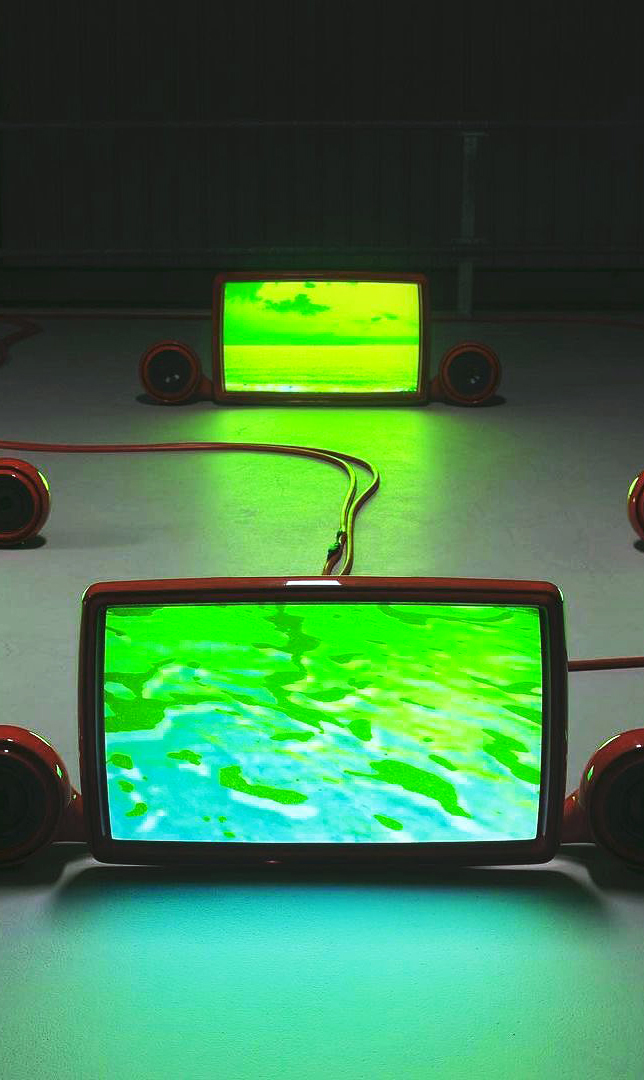
Studio Stallinga
Heimweh
‘Heimweh’ displays the breaking of waves on a sandy beach fragmented across 12 screens. The waves and their sound move gradually towards the feet of the spectator. At one point the waves turn into a green haze. ‘Heimweh’ started as a reflection on earthly life by considering what most embodies being on earth. When traveling to Mars, for instance, the major missing element would be the sea. As the waves turn green, they deform, similar to memories that get blurred over time. When the green finally subsides, the clear sky and sea emerge again with a sense of relief.

Eugenia Bakurin
La trahison des tapis
The title is a reference to the famous work by René Magritte “The Treachery of Images”. Even though the video installation alludes to it, the viewer is immediately aware that this is not a real carpet. What you see is an animation, a digital carpet, its contemporary variant. However, the patterns of the replica show that it could have been made in the west of Iran. The movements, which appear surreal, are reminiscent of a state of intoxication. Whether this was triggered by drugs, or only arose from the lively imagination of a tired child, is left to the speculation of the viewer. The work reflects the importance of traditional arts and crafts in the modern digital world. It is the first of a series of digital carpets.
The animation has a realistic resolution of 4k, is 03:55 minutes, and runs in an infinite loop on a 65-inch display.
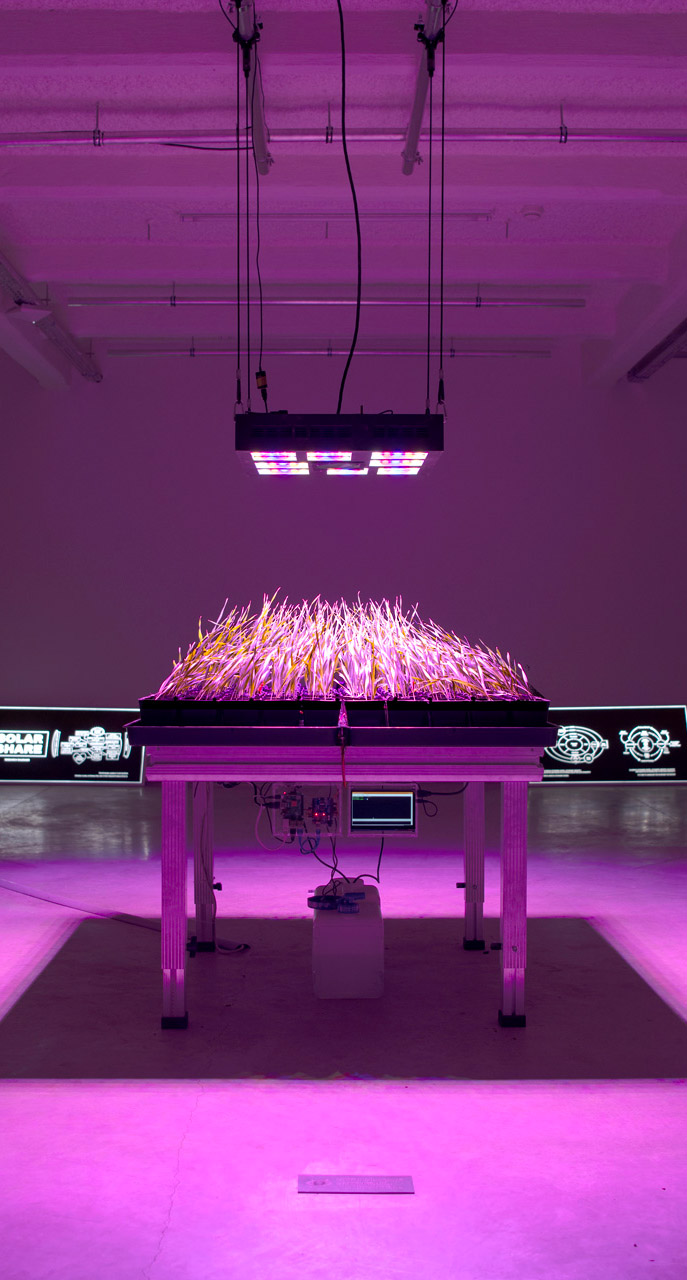
disnovation.org
LIFE SUPPORT SYSTEM (AKA. THE FARM)
This artistic provocation seeks to estimate the orders of magnitude of critical ecosystem services fundamental to all planetary life processes. This experiment consists of 1 square meter of wheat, cultivated in a closed environment. Critical inputs such as water, light, heat, and nutrients are measured, monitored and displayed for the public. This procedure makes palpable the immense scale of ecosystem contributions, and provides a speculative reference for a reckoning of the undervalued and over-exploited “work of the biosphere.”

Olafur Eliasson
Atmospheric Wall
大气波浪墙,一个新的文化地标和芝加哥首个公共艺术装置,由全球知名艺术家奥拉维尔·埃利亚松 (Olafur Eliasson) 设计。突出显示在外部杰克逊大道。墙,原件是专门为威利斯大厦创作的。大气波浪墙提供了一种免费且易于访问的方式,可以在 Loop 体验户外世界一流的艺术。
.
Atmospheric wave wall, a new cultural landmark and the first public art installation in Chicago by globally acclaimed artist Olafur Eliasson. Prominently displayed on the exterior Jackson Blvd. wall, the original piece was created specifically for Willis Tower. Atmospheric wave wall provides a free and accessible way to experience world-class art outdoors in the Loop.
.
Стена с атмосферными волнами, новая культурная достопримечательность и первая инсталляция в Чикаго, созданная всемирно известным художником Олафуром Элиассоном. Заметно отображается на экстерьере Jackson Blvd. стена, оригинальная часть была создана специально для Уиллис Тауэр. Стена с атмосферными волнами – это бесплатный и доступный способ познакомиться с искусством мирового класса на открытом воздухе в Loop.

Sabrina Ratté
FLORALIA I
Inspired by the writings of Donna J. Haraway, Ursula K. Le Guin, and Greg Egan, the work plunges us into a speculative future, where samples of then extinct plant species are preserved and displayed in a virtual archive room. Through editing and visual strategies, this archive room is sporadically transformed under the effect of interference caused by the memory emanating from the listed plants, revealing traces of a past that continues to haunt the place. Floralia is a simulation of ecosystems born from the fusion of technology and organic matter, where past and future coexist in a perpetual tension of the present.

Noriyuki Suzuki
*(asterisk)
“*(asterisk) is an installation comprised of an armillary sphere apparatus rotating an apple in 360 degrees and four cameras omnidirectionally scanning the surface of the apple in real-time. Computers calculate the similarity between fragmentary images of the present apple and apples I’ve eaten before, as if they were my memory of apples. The computations and compared apple-fragment images are shown on four displays respectively.” Noriyuki Suzuki

fabrica
recognition
RECOGNITION
Recognition, winner of IK Prize 2016 for digital innovation, is an artificial intelligence program that compares up-to-the-minute photojournalism with British art from the Tate collection. Over three months from 2 September to 27 November, Recognition will create an ever-expanding virtual gallery: a time capsule of the world represented in diverse types of images, past and present.A display at Tate Britain accompanies the online project offering visitors the chance to interrupt the machine’s selection process. The results of this experiment – to see if an artificial intelligence can learn from the many personal responses humans have when looking at images – will be presented on this site at the end of the project.Recognition is a project by Fabrica for Tate; in partnership with Microsoft, content provider Reuters, artificial intelligence algorithm by Jolibrain.
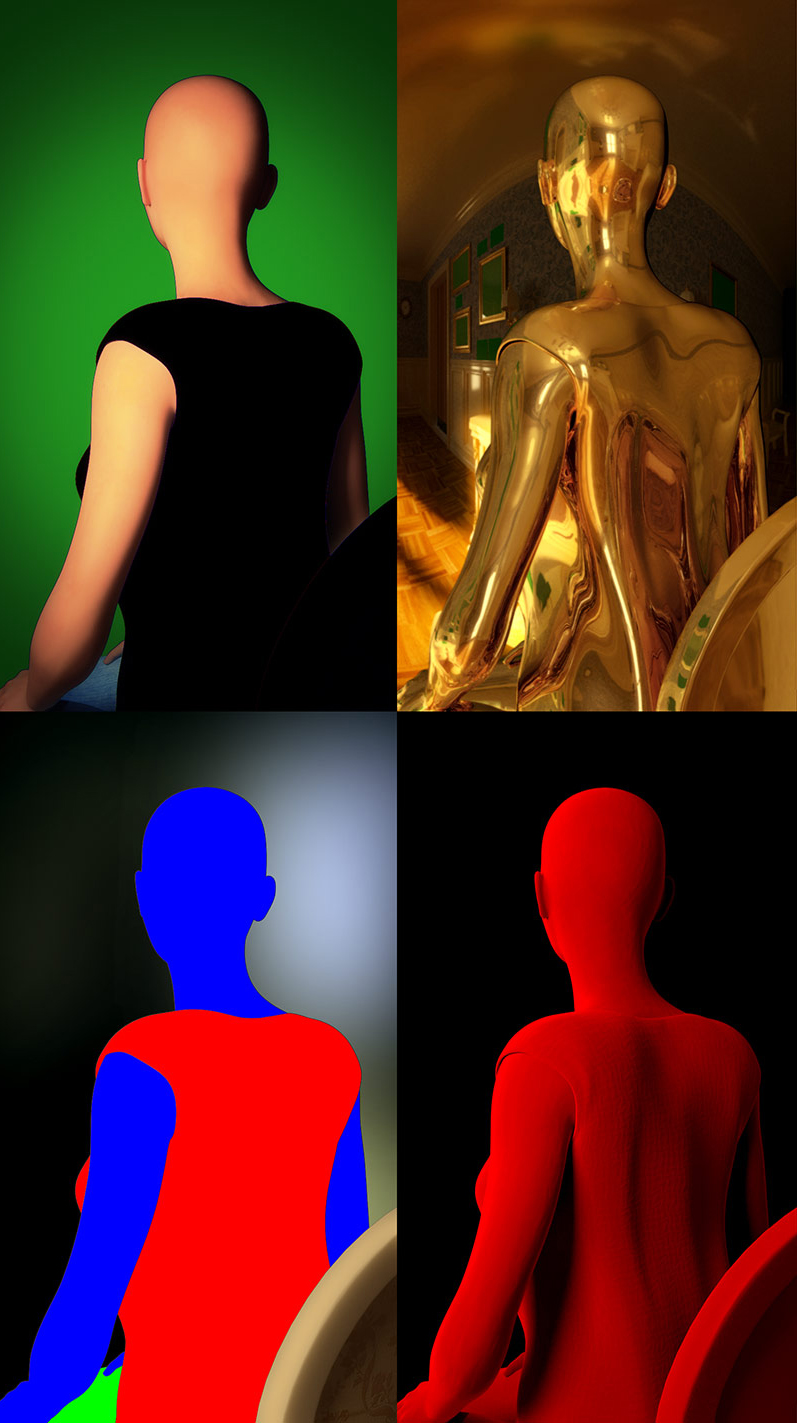
Alan Warburton
Spherical Harmonics
Spherical Harmonics is about the strange power of the CGI image. It’s a fantasy under construction, full of digitally created memories, counterfeit physics and controlled accidents. A place where reality fails because it’s too perfect. Spherical Harmonics sits stylistically at a halfway point between the glossy product displays of Oxford Street and the workhouse construction of Soho’s post production scene.

Anish Kapoor
Destierro
Destierro – which translates from Spanish into ‘exile’[…] features three installations that see Kapoor veering back towards his signature style of work with pigmented powder. However, unlike his previous work, the three pieces on display in Argentina shine a spotlight on the global migration crisis marking a change in direction for Kapoor who has, up until recently, shied away from making political work.

Chris Cheung
No Longer Write – Mochiji
Powered by artificial intelligence’s Generative Adversarial Networks (GANs), the collected works from ancient Chinese Calligraphers, including Wang Xizhi, Dong Qichang, Rao Jie, Su Shi, Huang Tingjian, Wang Yangming, as input data for deep learning. Strokes, scripts and style of the masters are blended and visualized in “Mochiji”, a Chinese literature work paying tribute to Wang Xizhi. Wang is famous for his hard work in the pursuit of Chinese calligraphy. He kept practicing calligraphy near the pond and eventually turned the pond for brush washing into an ink pond (Mochi). The artwork provides a platform for participants to write and record their handwriting. After a participant finished writing the randomly assigned script from “Mochiji”, the input process is completed and the deep learning process will begin. The newly collected scripts will be displayed on the screen like floating ink on the pond, and slowly merge with other collected data to present a newly learnt script. The ink pond imitates process of machine learning, which observes, compares and filters inputs through layers of image and text, to form a modern edition of “Mochiji”.
.
不再写 – Mochiji
以人工智能的生成对抗网络(GANs)为动力,将王羲之、董其昌、饶捷、苏轼、黄廷健、王阳明等中国古代书法家的作品作为深度学习的输入数据。向王羲之致敬的中国文学作品《麻糬》,将大师的笔触、文字、风格融为一体,形象化。王先生以对中国书法的刻苦钻研而著称。他一直在池塘边练习书法,最终把洗笔池变成了墨池(麻糬)。艺术作品为参与者提供了一个书写和记录他们笔迹的平台。参与者完成“Mochiji”中随机分配的脚本后,输入过程完成,深度学习过程将开始。新收集到的脚本会像池塘上的浮墨一样显示在屏幕上,并与其他收集到的数据慢慢融合,呈现出新学到的脚本。墨池模仿机器学习的过程,通过图像和文本的层层观察、比较和过滤输入,形成现代版的“年糕”。


ANDY LOMAS
Morphogenetic Creations
Created by a mathematician, digital artist and Emmy award winning supervisor of computer generated effects – Andy Lomas, Morphogenetic Creations is a collection of works that explore the nature of complex forms that can be produced by digital simulation of growth systems. These pieces start with a simple initial form which is incrementally developed over time by adding iterative layers of complexity to the structure.The aim is to create structures emergently: exploring generic similarities between many different forms in nature rather than recreating any particular organism. In the process he is exploring universal archetypal forms that can come from growth processes rather than top-down externally engineered design.Programmed using C++ with CUDA, the series use a system of growth by deposition: small particles of matter are repeatedly deposited onto a growing structure to build incrementally over time. Rules are used to determine how new particles are created, and how they move before being deposited. Small changes to these rules can have dramatic effects on the final structure, in effect changing the environment in which the form is grown. To create these works, Andy uses the GPU as a compute device rather than as a display device. All the data is held in memory on the GPU and various kernel functions are called to do things like apply forces to the cells, make cells split, and to render the cells using ray-tracing. The simulations and rendering for each of the different animated structures within this piece take about 12 hours to run, Andy explains. By the end of the simulations there are over 50,000,000 cells in each structure.The Cellular Forms use a more biological model, representing a simplified system of cellular growth. Structures are created out of interconnected cells, with rules for the forces between cells, as well as rules for how cells accumulate internal nutrients. When the nutrient level in a cell exceeds a given threshold the cell splits into two, with both the parent and daughter cells reconnecting to their immediate neighbours. Many different complex organic structures are seen to arise from subtle variations on these rules, creating forms with strong reminiscences of plants, corals, internal organs and micro-organisms.
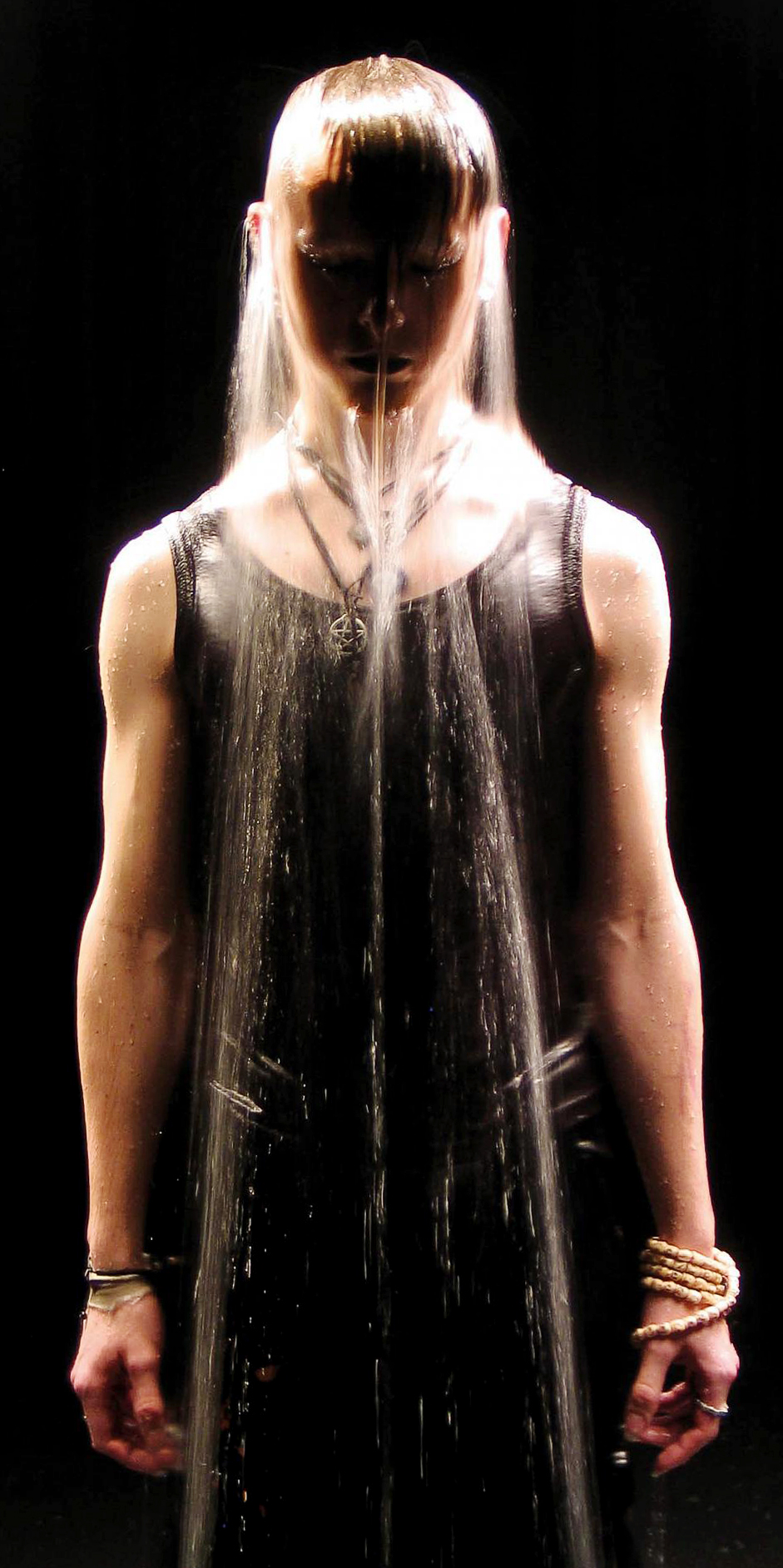
BILL VIOLA
Ein Ozean ohne Ufer
Ein Ozean ohne Ufer wurde erstmals während der Biennale der Weltkunst 2007 in Venedig in der entweihten Kirche von San Gallo ausgestellt und besteht aus über 240 Minuten hochauflösendem Inhalt, der auf 65- und 103-Zoll-Plasmadisplays angezeigt wird. Die Arbeit wird in einem vollständig synchronen, sich jedoch ständig weiterentwickelnden Format gezeigt, während sich Einzelpersonen kontinuierlich durch eine bemerkenswerte Welt von Violas Schöpfung bewegen.

Minimaforms
Emotive city
Emotive City is a framework to explore a mobile and self-organizing model for the contemporary city. Models of the past are limited and should not operate, as blueprints for our urban future, a new generation of design enquiry by necessity must address the challenges of today. The fixed and finite tendencies that once served architecture and urbanism have been rendered obsolete. Today the intersections of information, life, machines and matter display complexities that suggest the possibility of a much deeper synthesis. Within this context, architecture is being forced to radically refactor its response to new social and cultural challenges with an environment of accelerated urbanization. We propose a framework that participates and engages with the information-rich environments that are shaping our lives through a model of living that we call an adaptive ecology.

Eve Bailey
Rising Awareness
Could one succeed in rising the level of awareness by sharpening one’s perception rather than repeating the vapid catchphrase, “raising awareness,” which has been coopted by an ever-growing money-raising industry that fails to improve our circumstances in a substantive way? Wearing a cocktail dress, I assembled a large kinetic structure made of wooden beams and ladders in front of the audience. I then walked and balanced on the twenty-foot wide structure at eight feet off the floor. Rising Awareness addresses my ongoing preoccupations about the physicality of experience, inhabiting the body, proprioception as the possible strongest sense of self, how spatial awareness correlates with overall awareness and self-awareness, how physicality enhances creativity, finding balance between gravity and groundlessness, a concept of happiness as the fullest expression of one’s particular cognitive potential, pushing boundaries, and the current irreverent politics of liability.


Stelarc
Re-Wired / Re-Mixed: Event for Dismembered Body
“Re-Wired / Re-Mixed: Event for Dismembered Body” was a five-day, six-hour a day internet enabled performance, that explores the physiological and aesthetic experience of a fragmented, distributed, de-synchronized, distracted and involuntary body – wired and under surveillance. The artist wears a HUD (head up display) that enables him to see with the “eyes” of someone in London, whilst hearing with the “ears” of someone in New York. The body is also augmented by an 8 degrees-of-freedom exoskeleton so that anyone anywhere can generate involuntary movement of his right arm, using an online interface. The artist becomes optically and acoustically de-synchronized and performs partly involuntarily.

Klaus Obermaier
Face IT
The interactive installation FACE IT displays and exposes local people in a communicative setting where they are able to interact with faces of themselves or of other participants and at the same time become creative players and the stars of the artwork. This interactive situation not only creates a strong interplay between facial expressions and body movements, it also enhances these expressions and in the very best moments it creates a unique nonverbal language.

Timeblur Studio
Nadi Generative Art
Nadi is a Digital display of Kinetics and Energetics of Body Movements involved in Yoga. The visuals are created by investigating the flow of data, using the human body as a vehicle. With the support of computer vision technologies, a visual trail is formed by tracking the body movements during yogic postures. Inspired from Indian Yogic Science, we have visually depicted aspects of light, matter and energy in our forms. The generative nature of the visual comes from the digital juxtaposition of the poses that the body generates with each pose.

DANIEL BUREN
دانيال بورين
丹尼尔·布伦
다니엘 뷰렌
ダニエル·ビュラン
ДАНИЭЛЬ БЮРЕН
Daniel Buren a french conceptualist who is well known for his trademark work with stripes is oftentimes referred to as an abstract minimalist.
Challenging the conventional methods of displaying and presenting art, Buren gained notoriety at his first solo exhibition in 1968 when he glued green and white striped materiel to the exterior door of the Apollinaire Gallery in Milan. With a philosophy of reducing art into its more elemental forms while exploring the impact of repetitive motifs, his work with pattern, form and color draws attention to the surrounding environment and architectural framework rather than combating it. Instead of rejecting the environment in which his installations are produced, Buren integrates his art with the space and changes the fundamental nature of the space itself.

Jelle Mastenbroek
Splendour Lender
In Dutch history people expressed their status by displaying their most beautiful pieces of porcelain in the so called ‘pronkkasten’. This splendour lender is inspired by the ‘pronkkast’ and reflects upon status in modern times. How important is status in times of declining moral standards? In times where financial markets collapse, economies are shrinking and money tend to become a goal in itself? With this project I want to express the real nature of money and tell the true story of status; happiness. The splendour lender brings porcelain to life and shows the original function of money as a medium to exchange goods and services. By putting a euro coin you’ll experience a joyful moment. After usage the coin will be returned so the circle can go round.

Pangenerator
Hash2ash
Installation touches on the themes of selfie-culture, and the fear of permanently losing the digital records of our lives due to technical failures, impermanence of data storage, or simply because of the obsolescence of the old digital file formats. Even with such compulsive overproduction of the images of ourselves we might end up with nothing but the blank memories of our past. Even the data on ourselves will eventually fade away… The installation consist of the display that prompts you to take a selfie on your phone, which it renders in digital particles on its large 1×1 meter screen. Then a moment later, your face scatters and falls apart and the real black gravel starts to fall at the bottom of the screen in perfect synchrony with the digital simulation. Gradually a dark mound builds up at the foot of the construction.

GRINDER-MAN
Mirage
“MIRAGE” is the first performing art ever in the world to experience with immersive. This experience reminds us that we generate ourselves at each moment in our highly subjective ambiguous world. Unlike the general performing arts for the several audiences, “MIRAGE” is generated by the interaction of the two dancers and the one participant. As the participants, you are invited into an 8 minute immersive experience, using a head-mounted display fitted with headphones and a camera to capture live scenes. While unaware of the participant, dancer in front of the eyes is changed over to the dancer that has been recorded in advance. In addition, by overlapping the live scene and recorded ones, participants will experience simultaneous past and present. It is very difficult to tell which dancer is really existing or which is not. Each participant will be required to discover their own “reality”.
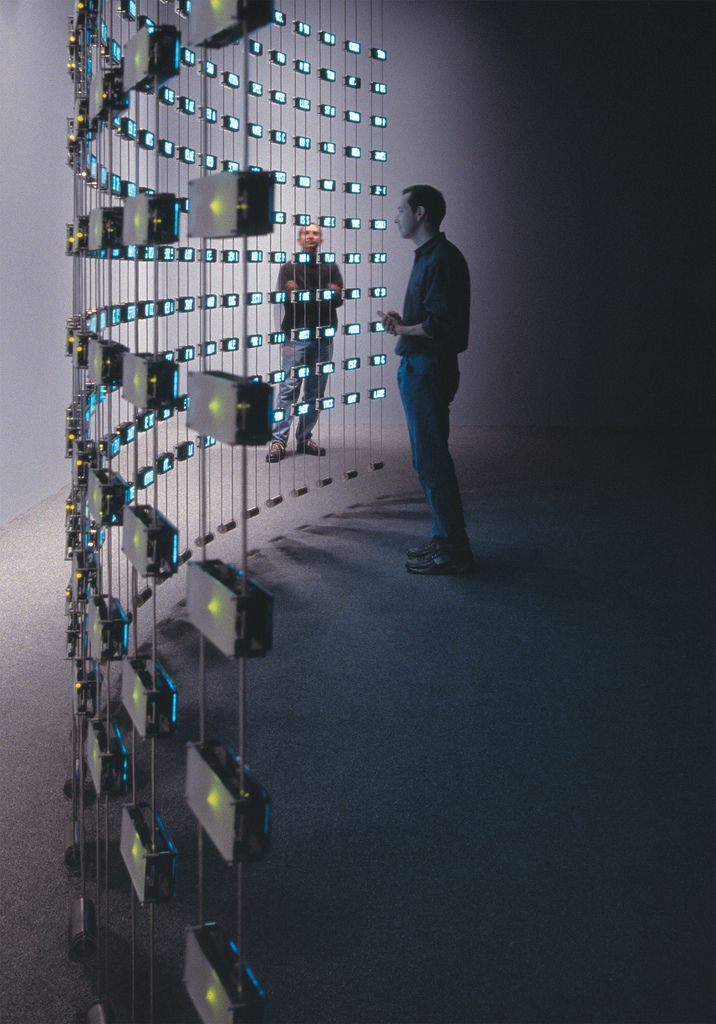
MARK HANSEN & BEN RUBIN
Марк Хансен и Бен Рубин
마르크 한센과 벤 루빈
Listening Post
Listening Post is an art installation by Mark Hansen and Ben Rubin that culls text fragments in real time from thousands of unrestricted Internet chat rooms, bulletin boards and other public forums. The texts are read (or sung) by a voice synthesizer, and simultaneously displayed across a suspended grid of more than two hundred small electronic screens.Listening Post cycles through a series of six movements, each a different arrangement of visual, aural, and musical elements, each with it’s own data processing logic.Dissociating the communication from its conventional on-screen presence, Listening Post is a visual and sonic response to the content, magnitude, and immediacy of virtual communication.
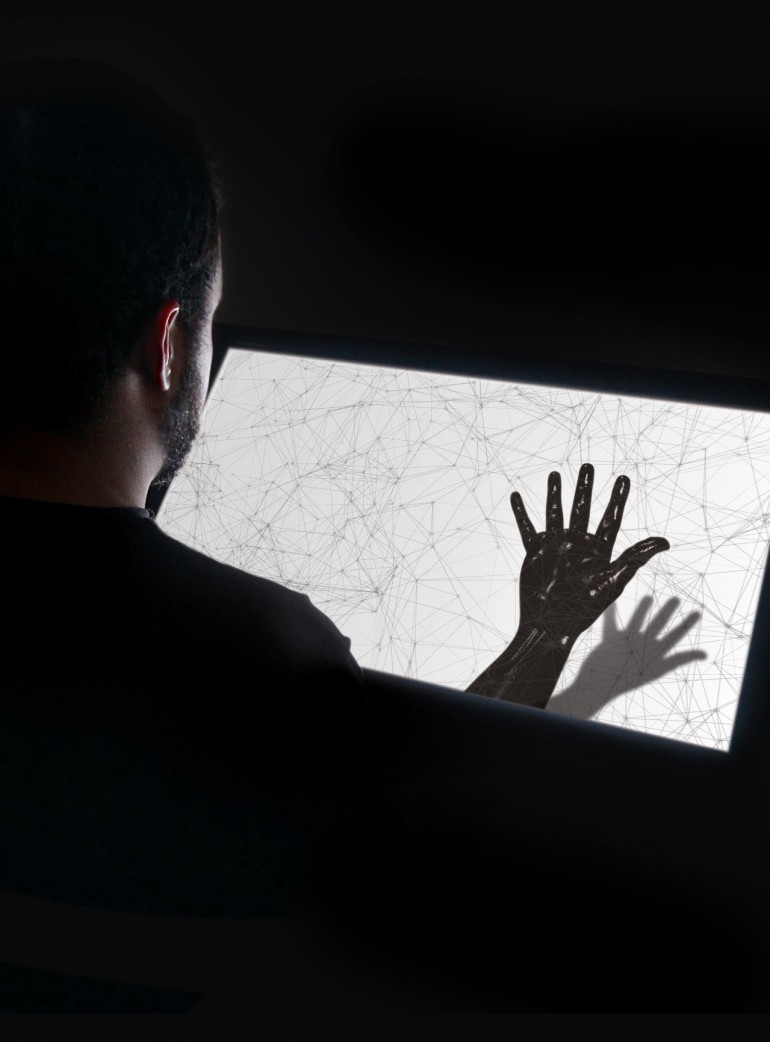
Índice
Jonattas Poltronieri, Luis Mello, Pedro Venetucci & Rofli Sanches
Phantom Limb
Just like the original box, the installation is a rectangular unit where the user inserts his arm and is urged to move it in different ways. The similarity with the original object disappears as, instead of having a mirror to provide the image that motivates the interaction, there is a screen that mediates the user’s view and the place where his arm actually is. The displayed image of the user’s arm can be reversed, distorted and coloured, among several modifications to simulate in a rich way the strangeness of not having control over a member, and to question whether what is seen is an accurate portrayal of the real body. Although deep and subjective, the topic addressed in this experience is easy and accessible in its interaction, offering various sensory feedbacks to the user. Through it, it is proposed that we experience and reflect upon the disconnection between thought and body, intention and action, sensation and reality.

Roman Vlasov
concept 47
Vlasov’s striking conceptual architecture hits upon contemporary’s most important design features: sharpness, elegance, simplicity, and sleekness. The juxtaposition between nature and the rigidity of a man-made structure accentuate the beauty of the construction. Aesthetically beautiful, Vlasov’s work is efficiently displayed from every angle.
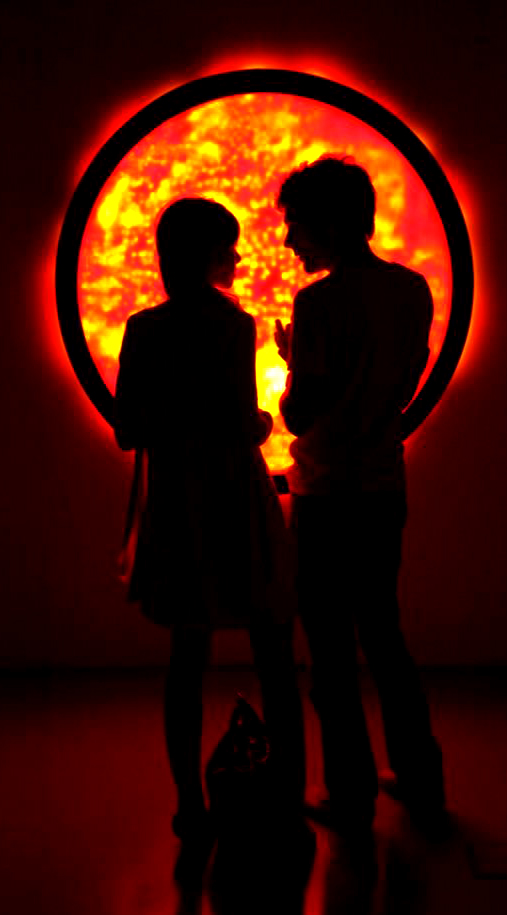
RAFAEL LOZANO HEMMER
Рафаэль Лозано-Хеммер
拉斐尔·洛萨诺 – 亨默
ラファエル·ロサノ=ヘメル
라파엘 로자노
רפאל לוזאנו, המר
Flatsun
A circular display that simulates the turbulence at the surface of the Sun using mathematical equations. The piece reacts to the presence of the public by varying the speed and type of animation displayed. If no one is in front of the piece the turbulence slows down and eventually turns off. As the built-in camera detects people more solar flares are generated and the fake Sun shows more perturbation and activity. At 140 cm diameter, Flatsun is exactly a billion times smaller than the real Sun. The piece consists of custom-made panels with 60,000 red and yellow LED lights, a computer with 8 processing cores, a camera with a pinhole lens and a mechanically engineered aluminium, steel and glass structure that pivots for maintenance. A single knob lets the collector set the brightness of the piece and turn it on and off.

Lisa Park
Eunoia II
It is an interactive performance and installation that attempts to display invisible human emotion and physiological changes into auditory representations. The work uses a commercial brainwave sensor to visualize and musicalize biological signals as art. The real-time detected brain data was used as a means to self-monitor and to control. The installation is comprised of 48 speakers and aluminum dishes, each containing a pool of water. The layout of “Eunoia (Vr.2)” was inspired by an Asian Buddhist symbol meaning ‘balance.’ The motif of number 48 comes from Spinoza’s ‘Ethics’ (Chapter III), classifying 48 human emotions into three categories – desire, pleasure, and pain. In this performance, water becomes a mirror of the artist’s internal state. It aims to physically manifest the artist’s current states as ripples in pools of water.

GeeksArt
Wavelet
It uses the changing light to mimic the flowing water. Wavelet is composed of 1,300 light-responsive light bulbs. Each light bulb is designed in an arc shape, which gives the light wave a distinct direction. Each of the teardrop-shaped light bulbs is embedded with custom-made electronics that detect and react to changes in light and colour. When any of the light bulbs detect a change in colour or light, it displays the colour accordingly. When any of of the lights are turned on, the adjacent light bulbs react to the light change and the light waves automatically expand out to the very edge of the installation. From a single source of light, waves spread out like a series of dominoes. The random variable patterns created give a pleasant surprise to the audience.

ROCIO VON JUNGENFELD
zones of flow (ii)
“zones of flow” is a work-in-progress project which investigates the fluid connections between people, sea and land. The piece zones of flow (ii) is an audiovisual artwork created to for the MAN display, which is located in a public area in NTU-Singapore; an open corridor where there is a regular flow of people moving across the space. The piece has come out of a sailing experience across the Atlantic in a 15m sailing boat. The ongoing project explores the instantaneous but sometimes asynchronous connectivity between things and people as they move in and across digito-tangible environments.

Hans van Manen
Polish Pieces
Alvin Ailey
Introdans
music: Henryk Mikołaj Górecki
Photographer: Hans Gerritsen
In this exuberant ensemble work, Dutch choreographer van Manen displays his mastery for building dazzling creations from simple motifs and geometric patterns. Driven by the rhythms of Henryk Górecki’s score, the dancers come together and disperse in endlessly shifting formations that culminate in two sensual pas de deux.

DOUG FOSTER
the psychotron installation
Now one of Doug’s stunning installations is available in edition format. The Psychotron Framed – a video piece based on the 12-petal lotus flower symbolising eastern spirituality’s heart chakra – has been harnessed into a purpose-built viewer that can hang on a wall or stand freely on a flat surface. The piece is currently only available by collection from The Outsiders London gallery. Order now and Doug will assemble the materials in two weeks.“For centuries, circular figures containing symmetrical patterns have been used as a tool for meditation,” says Doug of his original Psychotron on display at Bedlam. “The mandala, the yantra and visualisations of the various chakras, all conform to radial design principles that have been refined throughout the ages. Now those principles have been ruthlessly plundered for the creation of The Psychotron.

